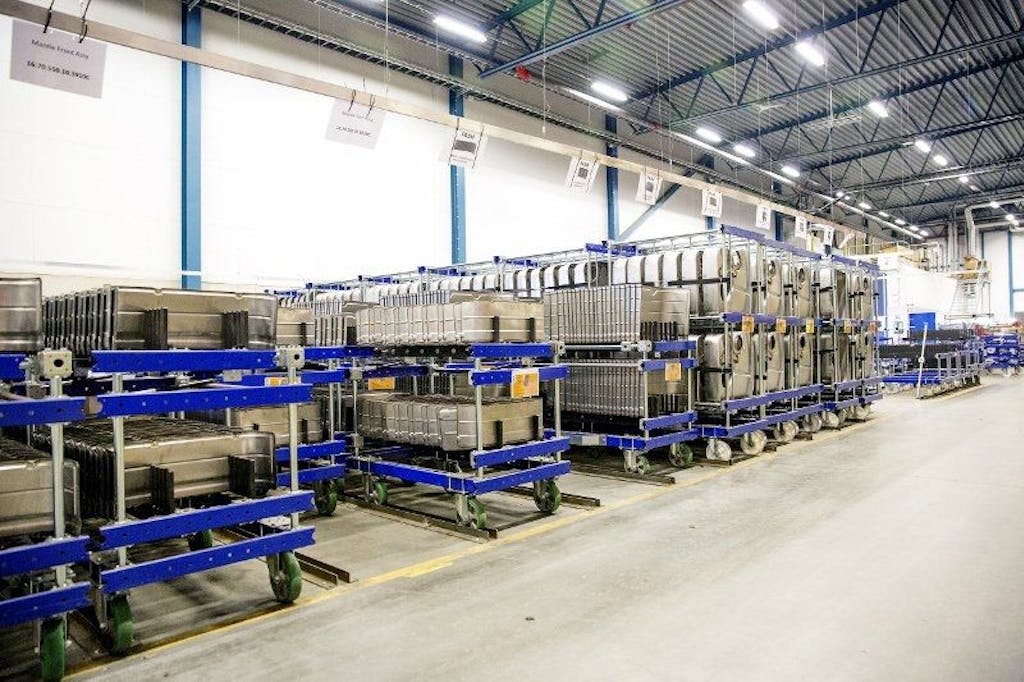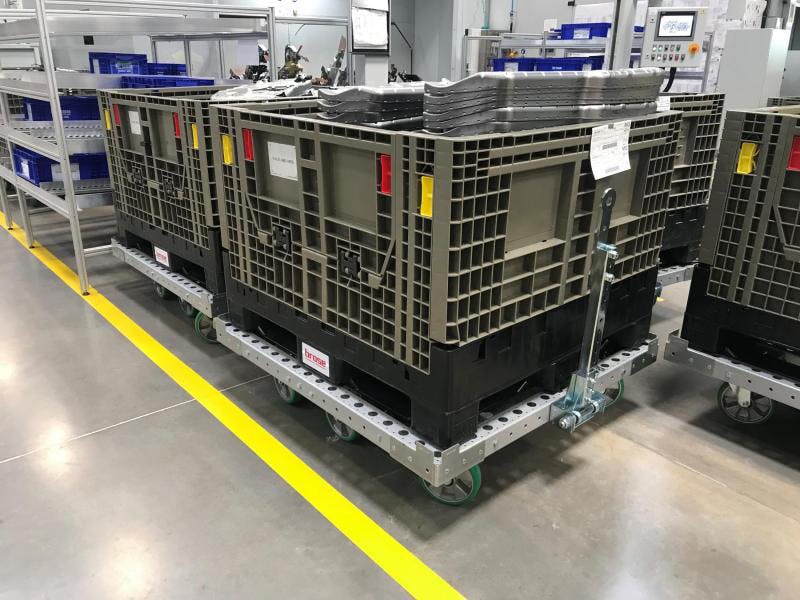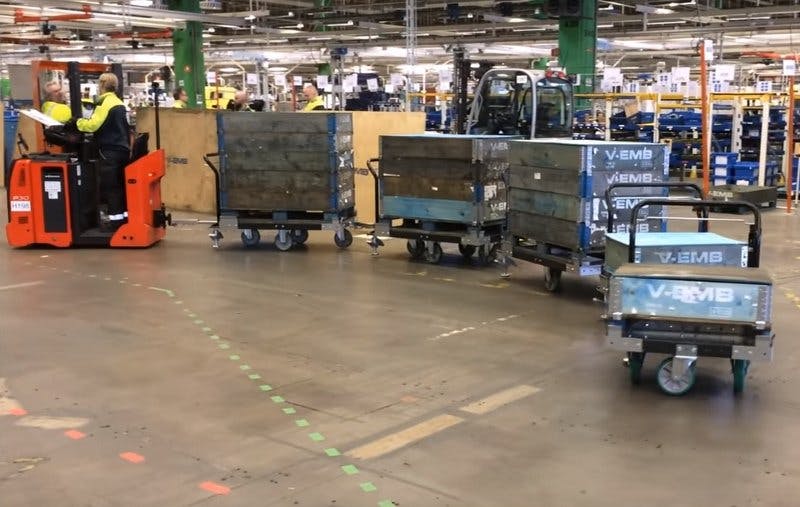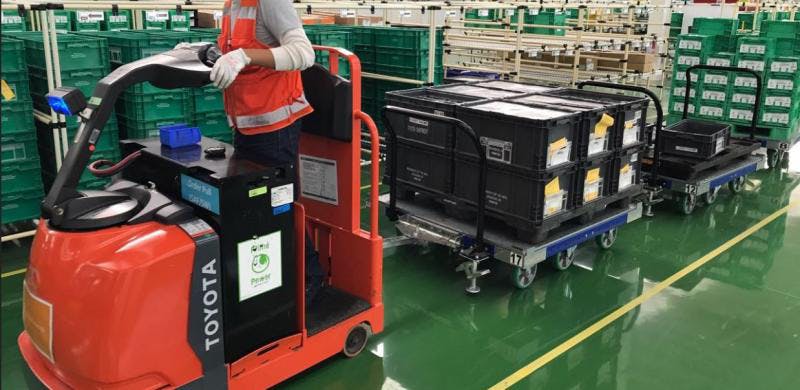A Guide To The Basics of Successful Material Handling

Last Modified: 2022.08.29
Material handling is essential in any logistics and manufacturing project. The global material handling market is expected to grow at a compound annual growth rate (CAGR) of 8.3 percent to 127.26 billion US dollars in 2025, making it important for companies to pick the proper solution for their projects.
There is a vast selection of material handling solutions, however, a majority of all physical commerce items are transported using tugger trains and carts.This guide will examine the role of tugger trains and carts in material handling and give you an idea of how to implement efficient material handling solutions, including its types, principles, and design.
What is material handling?
Effective material handling is the center of all operations for many large companies. Their operations’ safety and success significantly depend on transporting materials, work in progress, and finished goods from one area of the facility to another. Furthermore, it is critical to ensure timely order fulfillment, which leads to customer satisfaction.
In addition, the material handling process involves the movement, protection, storage, and control of materials. This handling process occurs in the following industries:
- manufacturing shop floors
- warehousing and distribution
- automotive and aeroscope
- food and beverage
- E-commerce and retail
- construction and hardware
- consumer goods and electrical appliances
- hospitals and pharmaceuticals
- chemicals, paper, and plastics
- material disposal
- and more.
Ensuring safety in workplaces where material transportation occurs is also a growing need across most industries. Efficient material handling processes can reduce accidents significantly.

start a project
Want to get in contact with us?
At FlexQube, we aim to find the right solution that suits your material handling processes – quickly. To make sure you find the right solution you are looking for, please feel free to contact us directly and schedule a meeting.
What are the main types of material handling?
There are two main types of material handling that operators and company owners need to know. And here they are:
01. Manual material handling
Manual material handling is where workers use their hands in moving individual containers. They lift, lower, fill, empty, or carry the containers when transporting them. However, this can be hazardous for workers since it exposes them to physical activities where they can be injured.
In most cases, workers suffer from sprains and strains in their lower back, upper limbs, and shoulders. Fortunately, there have been ergonomic developments made to reduce the risks in the manual handling of containers.
So, manual material handling carts refer to handling solutions that are operated and moved manually. These carts are generally equipped with wheels and handlebars for moving and steering the cart.
They are the most commonly used carts and can be found in every industry.
02. Automated material handling
Equipment is used in reducing or replacing manual handling of materials when economically and technically feasible.
In fact, many of the material handling machines available today are semi-automated due to human operator needs such as driving, unloading, or loading containers that are challenging and expensive to automate. Thanks to the ongoing improvements in machine programming, sensing, and robotics, there is a move to completely automate the handling of materials.
Automated material handling solutions include:
– Automated guided vehicles (AGVs): Automated guided vehicles are driverless electric vehicles used to transport materials within a facility. AGVs follow set paths using various navigation technologies. They also have collision warnings, enabling them to detect obstacles and stop.
– Autonomous mobile robots (AMRs): Autonomous mobile robots are equipped with advanced navigation technology, enabling them to map out a facility and determine their path as they move. They have developed sensors that allow them to identify obstacles and navigate around them.
– Conveyors systems: Conveyors are popular material handling solutions in many facilities. They effectively move goods quickly while minimizing the risk of damaging materials.
– Automated storage and retrieval system (AS/RS): An AS/RS is a computer-controlled system that automatically stores and retrieves materials with precision, accuracy, and speed.

What are the main principles of material handling?
It’s necessary to understand the principles involved in the material handling processes. They include:
– Orientation: This principle promotes assessing any available system relationship prior to the preliminary planning. It may include an evaluation of the problems and existing methods.
– Planning: When it comes to planning, it should involve the basic requirements, contingency planning, and other desirable alternates. Successful planning requires a team approach that involves consultants, suppliers, and users. In addition, it should align with the strategic objectives and promote concurrent process layout, design, and engineering of the product.
– Systems: This principle should integrate storage and handling activities that are cost-efficiently integrated into the system. Systems integration should address the entire supply chain, including suppliers, distributors, manufacturers, and customers. The system should minimize inventory levels without sacrificing order fulfillment and make it easier for one to identify materials,
– Unit load: A unit load is a load you can store or move as a single entity, such as a container, tote, or pallet. It is a single load regardless of the individual items that make it up. Unit loads should be appropriately configured and sized to achieve inventory and material flow objectives at every stage of the supply chain.
– Space utilization: This principle encourages the efficient use of available space. It is a three-step process that involves eliminating unorganized and cluttered areas, balancing the aim of maximizing storage density and accessibility, and finally considering overhead space while moving goods.
– Standardization: This principle encourages standardization of handling methods to improve equipment performance. Material handling techniques, controls, equipment, and software should be standardized with the aim of achieving overall performance objectives. However, standardization should not compromise flexibility, modularity, and throughput.
– Ergonomic: This seeks to adapt work and working conditions to a worker’s abilities. Material handling tasks and design must recognize human capabilities and limitations to ensure effective and safe operations. The equipment should eliminate strenuous and repetitive processes, which are the major causes of strains and sprains.
– Ecology: Effective material handling should be environmentally conscious. It should aim at reducing natural resource wastage and eliminating any adverse effects on the environment. Energy consumption and environmental impact should be key considerations when designing a material handling system.
– Mechanization: This is to encourage efficiency in handling materials. Material handling should focus on automation using computer-based systems and electro-mechanical devices to control and operate material flow.
– Simplification: Simplified processes are better than complex methods as they remove unnecessary movements. Such techniques reduce, eliminate, shorten, or combine unnecessary procedures to minimize work. You should use the shortest distance to move materials within the facility.
– Obsolescence: This principle encourages equipment preparation policy to take advantage of material handling tools economically. Managers should plan for predictive and maintenance costs of all machines, equipment, and tools. All equipment should be replaced when it becomes obsolete.
Design of material handling systems
Businesses create a place and time utility through the help of material handling. It’s most helpful for retail stores, warehouses, and manufacturing plants. In the job of all production workers, material moving equipment plays a vital role.
When it comes to design, material handling systems have an integral structure to efficiently manage the flow of materials between activities of production systems.
Therefore the design of material handling systems involves the following:
Concept of unit load

Unit load means the item’s single unit, or several units combined as a single unit to maintain integrity.
While liquid, gaseous, and granular materials may be moved in bulk, they may also be combined into multiple unit loads through cylinders, bags, and drums. The main advantage is that more items are handled simultaneously.
Therefore, it reduces the required number of moving trips while possibly decreasing handling costs, product damage, and loading/unloading times.
In-process handling
In terms of in-process handling, unit loads are received, stored, and shipped for distribution.
The process includes determining:
- the weight
- configuration
- size and type of loads
The method and machine used in handling the loads are also involved in the design of the unit load. In addition, it covers how the load is formed and broken down during in-process handling.
However, it’s important to keep in mind that unit loads shouldn’t be bigger than the size of the production batch in process.
Distribution
For the distribution part, it’s important to choose the exact unit load before transporting items. This can be challenging since the pallets or containers are only available in specific configurations and standard sizes.
Rail boxcars, airplane cargo bays, and truck trailers are restricted in height, length, and width.
Also, the feasible pallet or container sizes for loads are limited to the storage rack and warehouse configurations as well as the retail store shelves and customer carton sizes.
The solution can be customized pallet & container carts such as those offered by FlexQube. We offer pallet and container carts of any size! The tough, adjustable, modular solution for all of your material handling needs.

The next step: AGV System
The AGV is the next step for FlexQube in helping its customers take their first steps into automation. The goal of the AGV is to offer the world’s most user-friendly automation solution for internal logistics and material handling.
The FlexQube AGV was born out of the idea of improving simple material flows and routes by automating them with a motorized cart. Originally, automation has been linked to having an automated robot pulling non-automated trolleys holding the material behind it. The AGV has looked at merging these two ideas together.
Read the 6 most asked questions about the AGV
Listen to our CTO, Per Augustsson talk about the AGV story in this webinar recording below:
3 steps for successful material handling management
With the complex processes of material handling needed in moving containers and loads, it’s essential to understand how to start, conduct, and implement a successful material handling project.
Using automated equipment has been perceived to be a costly and risky investment. However, this is the best way to save on material handling projects while getting the exact hardware needed on the building site.
01. Start with the original source of the equipment
When it comes to assessing material handling equipment, a physical evaluation is important.
It helps in assessing the equipment in order to determine how to best take advantage of them. Start with the original source of the equipment.
Consider the specifications, drawings, programs, service records, and spare parts list to make sure the equipment meets your exact needs. This will help you determine the right transportation method.
For example, manual transportation may be your best method. There is also numerous equipment under this method of transportation, such as tugger carts. Alternatively, you can choose automated transportation such as AGVs, AMRs, and conveyors. However, the type of materials you transport will also influence your method of transportation.
02. Choose the right material handling equipment
Raw materials play a vital role in the manufacturing industry and service organization. In any business, material handling can be done in several ways depending on the specific requirements of the company.
Whether you are choosing the automated or manual process, finding the best tools and equipment is important. Material handling equipment is generally categorized into four main categories:
– Bulk handling material equipment: This equipment handles, transports, stores, and controls bulk materials. They include hoppers, reclaimers, stackers, and bucket and grain elevators.
– Engineered systems: These are automated systems consisting of several pieces of equipment. They include AS/SR, conveyor systems, robotic delivery systems, and AGVs.
– Industrial trucks: Industrial trucks assist with material transportation and consist of a wide range of equipment tailored for specific transportation needs. They include pallet trucks, hand trucks, side loaders, and order pickers.
– Storage and handling equipment: This equipment helps organize and store materials safely. It is generally classified into dynamic and static storage. Dynamic storage stores materials for short periods, while static storage holds materials for a longer period. This equipment includes stacking frames, racks, drawers, bins, and shelves.
03. Implement material handling best practices
One of the best ways of ensuring that your material handling is effective is to adapt the best material handling practices. These practices include:
– Safe material handling: Ensure you use the best practice for safe material handling. This involves training employees on safe lifting and carrying techniques, providing personal protective equipment, and having a safety program.
– Leverage on automation: Automation is the catalyst for efficiency and process improvement in the warehouse environment.
– The put-away process: This process involves putting away materials the same day they are received. It helps save on space, minimize transaction errors, and reduce damage to materials or goods.
– Warehouse management system (WMS): A WMS can help track travel time from receipt to storage. It can also assist in inventory visibility and in tracing materials.
– Organized warehouse: A clean, neat, and organized warehouse is more efficient in material handling. Poor conditions can cause safety risks, time wastage in looking for materials, and material damage.

Tugger trains and tugger carts in material handling
Today, intralogistics processes such as material supply distribution from warehouses to production lines are becoming a big challenge for many factories across the globe.
Forklifts don’t seem to be enough to handle material transport requirements, so they are now becoming history in the logistics industry. Tugger trains and tugger carts are currently the stars of material handling in Europe, Asia, the USA, and Scandinavia.
These flexible carts are not welded to adapt to various scenarios and the needs of operators and workers. For many businesses existing today, material carts are simpler and more efficient to use.
The design and structure of the FlexQube tugger carts are adaptable to the current needs while they can withstand heavy unit loads. The build of material carts also consists of FlexQube’s core building blocks in standardized dimensions to simplify handling processes.

Tugger train systems have the same function as a real train but on a smaller and more focused scale
Here are some of the most common intralogistics projects that help modify the material handling industry:
- building new plants
- launching new products
- improving work stations
- implementing part kitting
- lessening forklift traffic

The design and structure of the FlexQube tugger carts are adaptable to the current needs
Other essential material handling tools
With the changing needs of the industries worldwide, businesses also need to keep up with the changes to survive the competition and be able to supply the demands of consumers.
When it comes to material handling, change is also constant just like in other industries, so a lot of improvements were made in the material handling aspect. Today, using material handling tools such as:
- mother/daughter carts
- pallet carts
- shelf carts
- rotating carts
- tilt carts
- flow racks
- kit carts
- and transport racks are the latest trend.
Benefits of the innovative material handling systems
The latest developments in material handling systems support the needs of various companies that require handling equipment.
With the complex material handling processes, it is truly a great advantage to have a feasible material handling system that adapts to the unique needs of operators and industrial companies.
The following are the helpful benefits of using material carts and trains in transporting containers or unit loads from the warehouse to the building site:
- save money
- increase safety
- reduce downtime
- improve ergonomics
- increase efficiency
- reduce fork transport traffic
- increase capacity
- save space
- increase flexibility
- improve the work environment
Whether you are an assembler, production engineer, logistic operator, logistics engineer, maintenance engineer, safety engineer, or the management head, material handling carts, and trains are the best options today.
Innovative handling equipment improves work efficiency while reducing wastes generated by damage or careless usage.
Automation is a way to go
The ongoing move to Industry 4.0 and a smarter work or manufacturing space is also reliant on proper material handling.
Here again, making use of semi-automated or fully automated systems is the way to go. The benefits of this material handling solution include reducing downtime and accelerating just-in-time delivery and production.
When materials are properly handled, the number of lost or damaged materials is also reduced.
In addition, a methodical and efficient manner of material handling promotes a cleaner work environment. Some may believe that automated equipment is a risky investment, but with proper management, they are more beneficial than other tools and machines used by industries today.
Browse our collection of material handling carts which are ideal for creating more efficient material handling systems. Get in touch, tell us about your requirements, and our team will help you find the right solution for your facility.


